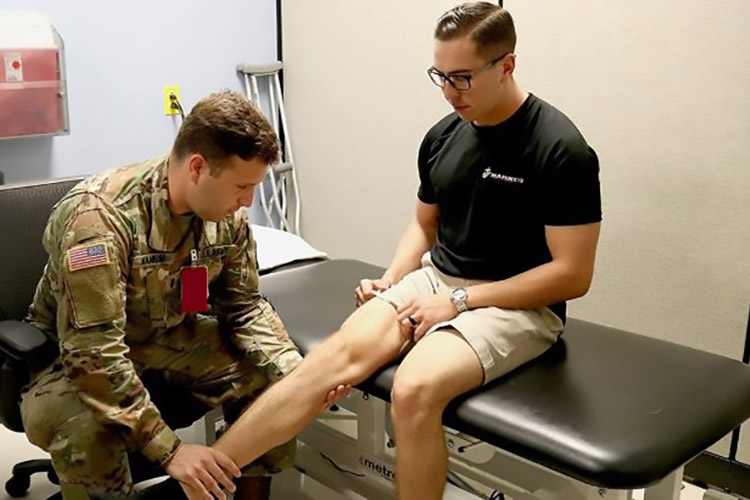Surveillance snapshot: Illness and injury burdens, reserve component, U.S. Armed Forces, 2021
 Army 1st Lt. Nicholas Wankum, a physical therapist at Madigan Army Medical Center, evaluated the progress Marine Staff Sgt. Dalton Everhart made in his range of motion since the recruiter came to the emergency department after an injury nearly a month before this September 2019 visit (U.S. Army photo).
Army 1st Lt. Nicholas Wankum, a physical therapist at Madigan Army Medical Center, evaluated the progress Marine Staff Sgt. Dalton Everhart made in his range of motion since the recruiter came to the emergency department after an injury nearly a month before this September 2019 visit (U.S. Army photo).
You also may be interested in...
Article
Jun 1, 2019
As in prior years, mental health disorders, pregnancy-related conditions, and injury/poisoning accounted for the majority (59.8%) of all hospitalizations among active component service members in 2018. However, the hospitalization rate for all causes was the lowest rate in the past 10 years.
Article
Jun 1, 2019
As in prior years, mental health disorders, pregnancy-related conditions, and injury/poisoning accounted for the majority (59.8%) of all hospitalizations among active component service members in 2018. However, the hospitalization rate for all causes was the lowest rate in the past 10 years.
Article
Jun 1, 2019
The U.S. Millennium Cohort Study is a population-based prospective study that includes over 200,000 current and prior U.S. military service members.
Article
Jun 1, 2019
Diarrheal illnesses have an enormous impact on military operations in the deployed and training environments. While bacteria and viruses are the usual causes of gastrointestinal disease outbreaks, 2 Joint Base San Antonio–Lackland, TX, training populations experienced an outbreak of diarrheal illness caused by the parasite Cyclospora cayetanensis in ...
Article
Jun 1, 2019
The natural human sex ratio at birth (male:female) slightly favors males, and altered sex ratios might be indicative of exposure to reproductive hazards.
Article
May 1, 2019
The number of medical evacuations for battle injuries has decreased considerably since 2014. Most medical evacuations in 2018 were attributed to mental health disorders, followed by non-battle injury/poisoning; signs, symptoms, and ill-defined conditions; musculoskeletal disorders; and digestive system disorders.
Article
May 1, 2019
Musculoskeletal disorders and mental health disorders accounted for more than half (52.6%) of all illness- and injury-related ambulatory encounters among active component service members in 2018. Since 2014, the number of ambulatory visits for mental health disorders has decreased, while the numbers of ambulatory visits for musculoskeletal system ...
Article
May 1, 2019
Surveillance Snapshot: Illness and Injury Burdens, Recruit Trainees, Active Component, U.S. Armed Forces, 2018
Article
May 1, 2019
Surveillance Snapshot: Illness and Injury Burdens, Reserve Component, U.S. Armed Forces, 2018
Article
May 1, 2019
Among service members deployed during 2018, injury/poisoning, musculoskeletal diseases, and signs/symptoms accounted for more than half of the total health care burden while deployed. Compared to the distribution of major burden of disease categories documented in garrison, a relatively greater proportion of in-theater medical encounters due to ...
Article
May 1, 2019
As in prior years, mental health disorders, pregnancy-related conditions, and injury/poisoning accounted for the majority (59.8%) of all hospitalizations among active component service members in 2018. However, the hospitalization rate for all causes was the lowest rate in the past 10 years.
Article
May 1, 2019
In 2018, mental health disorders accounted for the largest proportions of the morbidity and healthcare burdens that affected the pediatric and younger adult beneficiary age groups. Among adults aged 45–64 years, musculoskeletal diseases accounted for the most morbidity and healthcare burdens, and among adults aged 65 years or older, cardiovascular ...
Article
May 1, 2019
In 2018, mental health disorders accounted for the largest proportions of the morbidity and healthcare burdens that affected the pediatric and younger adult beneficiary age groups. Among adults aged 45–64 years, musculoskeletal diseases accounted for the most morbidity and health care burdens, and among adults aged 65 years or older, cardiovascular ...
Article
Apr 1, 2019
Risk factors for heat illnesses (HIs) among new soldiers include exercise intensity, environmental conditions at the time of exercise, a high body mass index, and conducting initial entry training during hot and humid weather when recruits are not yet acclimated to physical exertion in heat. This study used data from the Defense Health Agency’s ...
Article
Apr 1, 2019
Among active component service members in 2018, there were 545 incident diagnoses of rhabdomyolysis likely due to exertional rhabdomyolysis, for an unadjusted incidence rate of 42.0 cases per 100,000 person-years. Subgroup-specific rates in 2018 were highest among males, those less than 20 years old, Asian/Pacific Islander service members, Marine ...
You are leaving Health.mil
The appearance of hyperlinks does not constitute endorsement by the Department of Defense of non-U.S. Government sites or the information, products, or services contained therein. Although the Defense Health Agency may or may not use these sites as additional distribution channels for Department of Defense information, it does not exercise editorial control over all of the information that you may find at these locations. Such links are provided consistent with the stated purpose of this website.
You are leaving Health.mil
View the external links disclaimer.
Last Updated: July 11, 2023